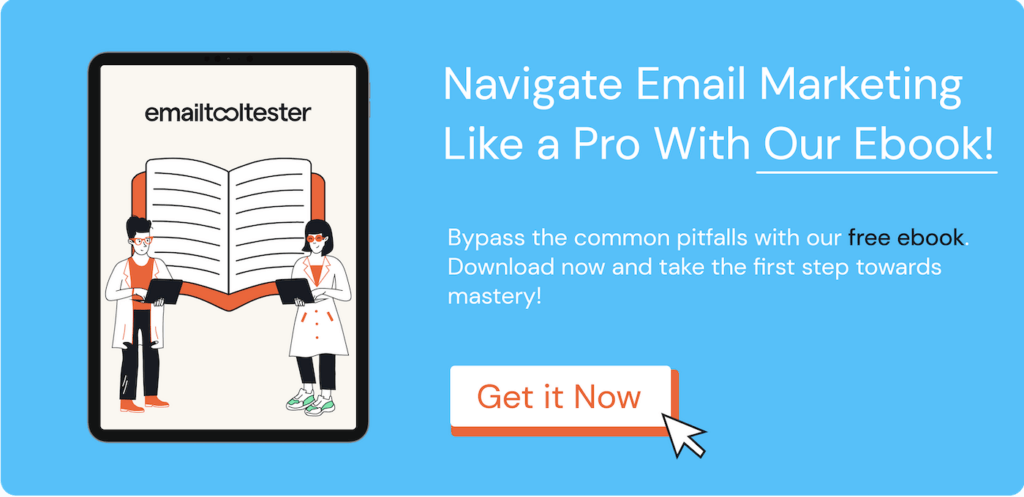Noticing a drop in engagement? If your open and click-through rates are slipping, it’s time to re-engage your subscribers. A well-crafted email can help you bring them back and boost those numbers.
Re-engagement emails have the potential to win back up to 45% of inactive subscribers (according to a study by Validity’s Return Path) and turn them into customers. But it’s not as simple as sending a “we miss you” or “hey…you still there?” email.
The most effective re-engagement emails are personalized, value-packed, and action-driven. These emails don’t just remind subscribers you exist; they motivate them to take the next step.
In this guide, you’ll discover 10+ re-engagement email examples you can swipe to craft your own emails. By the end, you'll have fresh ideas and pro tips to revive your inactive subscribers and win back customers.
Let’s dive in.
What is a re-engagement email?
You’re probably familiar with what re-engagement emails are since you’re reading an “examples” post. But let’s quickly review the basics.
A re-engagement email is a targeted email you send to disengaged customers or inactive subscribers to encourage interaction with your business. This could mean getting them to engage with your emails (again) or nudging them to make a purchase.
But why bother re-engaging disengaged or inactive subscribers?
First of all, retaining a customer (or subscriber) is far cheaper than acquiring a new one. Plus, email algorithms (yes, they exist as ISPs like Gmail) prioritize engagement. If your list is filled with unresponsive and “dead” subscribers, your emails risk being marked as spam.
Now that we’ve covered the what and why, let’s get into the examples of re-engagement emails that can help you win back subscribers and customers.
13 Re-engagement Email Examples (+ Why They Work)
Whether you’re reconnecting with inactive subscribers or enticing previous customers to buy again, these re-engagement email examples cover different strategies.
A. Reconnection re-engagement emails
These “we miss you” re-engagement emails tap into subscribers’ emotions and create a sense of connection. They make subscribers feel like they’ve been missed or are missing out on something.
“Here’s what you missed”
This type of re-engagement email highlights valuable updates to remind subscribers of the benefits you offer. By teasing exciting updates or helpful content, you can create a sense of urgency and curiosity, prompting your subscribers to engage so they don’t miss out.
Subject line ideas:
- It’s been a while…here’s what you missed
- Here’s what you’ve been missing, [First Name]
- Hey [First Name], we’ve got some catching up to do”
Re-engagement email example:
Check out this example from Venmo. The headline is punchy and playful, with a clever contradiction of the words “new” and “old” that grabs attention and makes the brain pause. Also, the body copy doesn't just list features; it gives a quick, benefit-driven teaser that makes you want to learn more.

Venmo’s email on Really Good Emails
“Are we breaking up?”
This type of email uses the metaphor of a breakup to grab attention. It’s fun and lighthearted, yet direct without being pushy. Essentially, it invites subscribers to decide whether they still want to hear from you – prompting them to take action.
Subject line ideas:
- Are you ghosting us?
- Should we stay together?
- Are we breaking up, [First Name]?
Re-engagement email example:
This Myles Apparel email is an excellent example of using a “breakup metaphor” to grab attention. The tone is casual and conversational, blending humor and pop-culture references to make subscribers drop their guard.
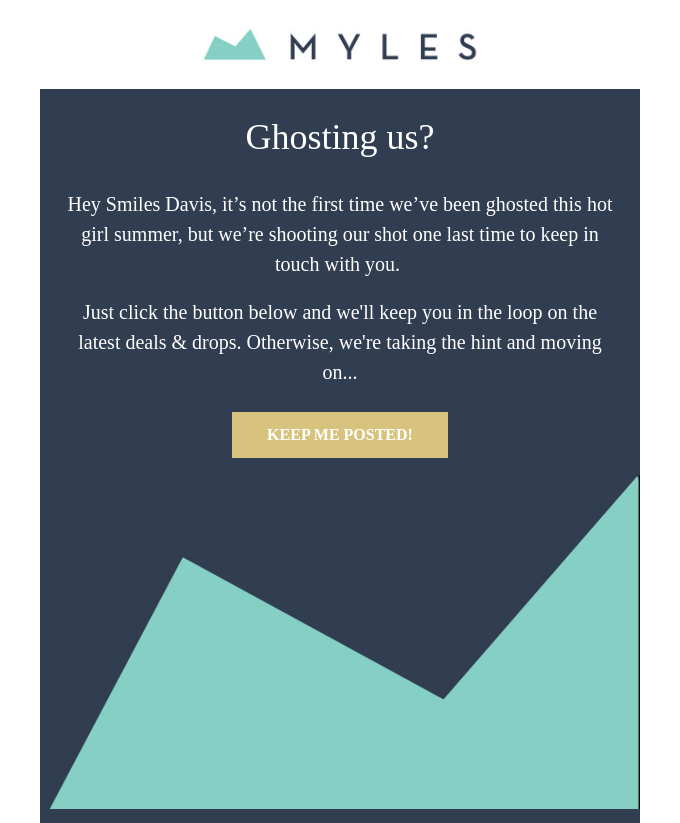
Myles Apparel’s email on Really Good Emails
B. Incentive-based re-engagement emails
These re-engagement emails offer subscribers rewards like discounts, freebies, or special offers to reignite their interest. After all, who doesn’t love a good incentive? However, be careful not to overuse this tactic, as it may lead subscribers to only engage when there’s a discount involved.
“Come back and get [discount]”
This email grabs attention with an immediate benefit like a discount offer. It’s a straightforward appeal that speaks directly to subscribers’ wallets. And the promise of getting something valuable pushes them to take action.
Subject line ideas:
- Come back and get [Exclusive Discount]
- Your exclusive [X%] off is waiting, [First Name]
- Here’s a special discount to say we miss you
Re-engagement email example:
This re-engagement email from Busuu is a straight-up quid pro quo: “Come back and get 50% off.” That’s it. The focus is purely on the incentive. And if pricing were the barrier to engagement, subscribers would likely grab the offer.

Busuu’s email on Really Good Emails
“A special gift just for you”
This approach adds a personal touch to discount re-engagement emails. The offer is tailored specifically to each inactive subscriber based on their behavior or interests, making it feel like a thoughtful gesture rather than just another discount deal.
Subject line ideas:
- A special gift just for you, [First Name]
- We’ve got something special waiting for you
- [First Name], enjoy this exclusive gift from us
Re-engagement email example:
Unlike the generic discount offer in the last example, this Busuu re-engagement email takes a more personalized approach. It reframes the discount as a gift, exclusive to the subscriber, which makes it feel less like a bribe and more like a gesture of appreciation. Instead of just offering a deal, it makes the subscriber feel truly valued.
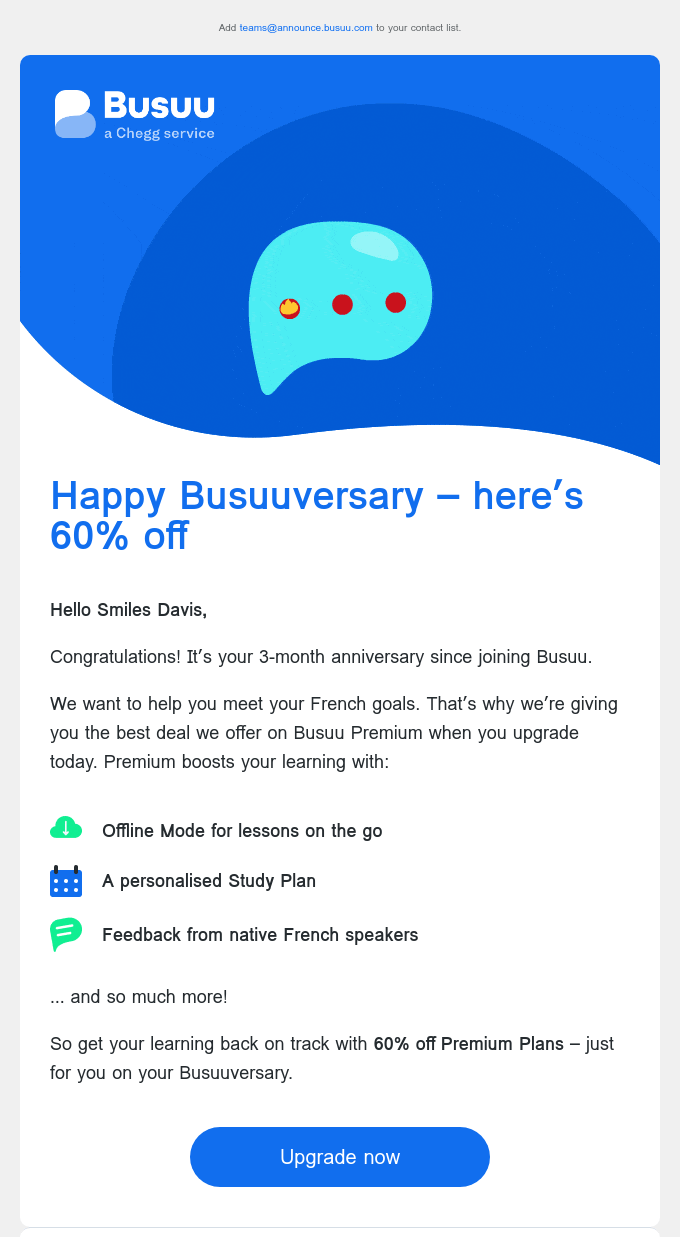
Busuu’s email on Really Good Emails
“Your VIP status is expiring”
Using scarcity and urgency to reignite interest is a tried-and-true strategy. This type of re-engagement email reminds subscribers of their special status and taps into the fear of losing access to exclusive perks. People love being a part of an exclusive group and will take action to keep their VIP status.
Subject line ideas:
- Last chance to keep your VIP perks!
- Your VIP benefits are about to disappear…
- Your VIP status is expiring soon, [First Name]!
Re-engagement email example:
I love how Withings played the FOMO and urgency in this re-engagement email. It’s not just “you're missing out.” It's “you’re about to lose something exclusive.” Something reserved for someone of your status.
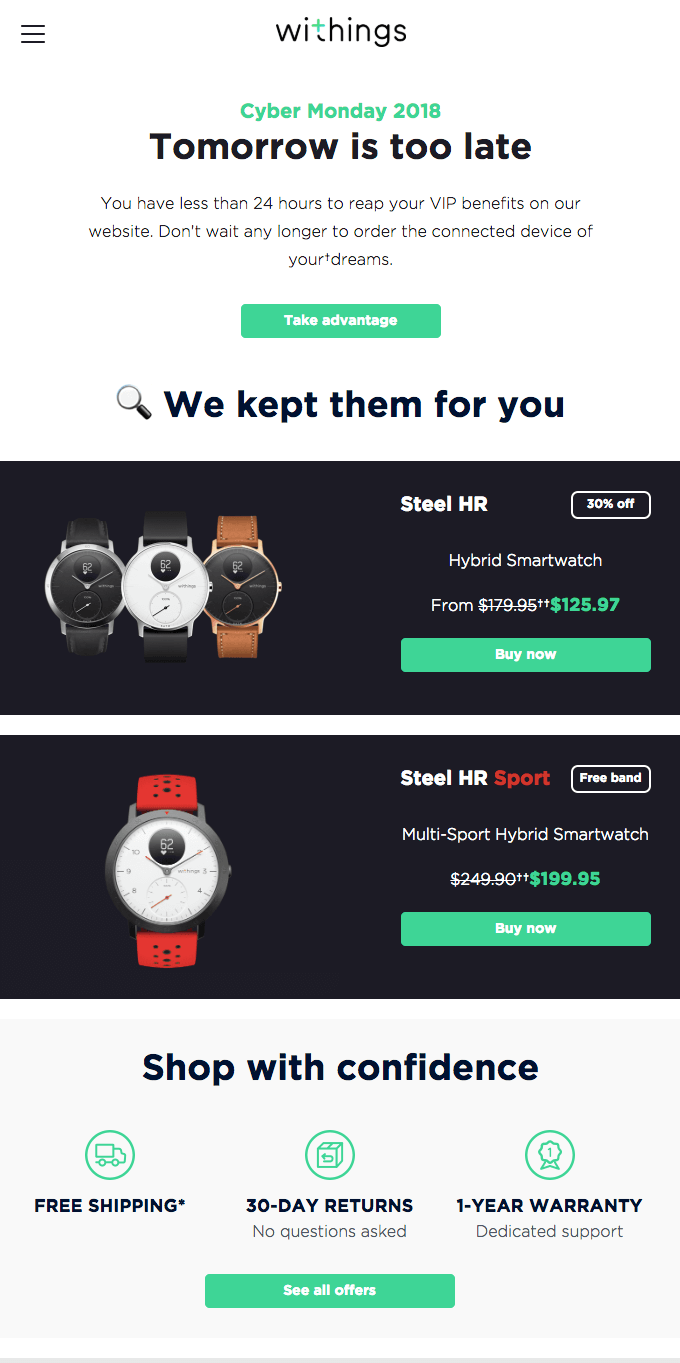
Withing’s email on Really Good Emails
“Look who’s loving this”
Social proof is a powerful tool for reengaging subscribers. By sharing replies and testimonials from others engaging with your content (or grabbing your offer), subscribers will feel they’re missing out and will want to join.
Subject lines:
- Everyone is talking about this…
- I got X replies to my last email about X
- Look at all the buzz around [Product/Service]
Re-engagement email example:
Skillshare nails it in this example by using testimonials from real people to build credibility and trust. But, showcasing what others are experiencing also triggers FOMO. The added bonus of a generous discount offer pushes them even further to join in and enjoy Skillshare’s benefits. 
Skillshare’s email on Really Good Emails
C. Response re-engagement emails
These re-engagement emails are sent in direct response to subscribers' inaction or action (like cart abandonment or subscription cancellation). The goal is to prompt them to complete or reconsider their original action.
“Did you forget about this?”
This re-engagement email is commonly used for abandoned carts. It reminds prospects of a purchase they abandoned or an item they showed interest in, to make them complete the purchase.
Subject line ideas:
- We saved your cart, just in case
- Did you forget about this, [First Name]?
- You left something behind, [First Name]
Re-engagement email example:
Expecting an ecommerce example? Well, abandoned cart emails also work for other industries – even for something like subscriptions. If you own a newsletter, you might want to swipe this example from New York Magazine.
The “What You're Missing Out On” section is a masterclass in direct-response copywriting. Those story sneak peeks would make anyone curious and reconsider what they’re walking away from.
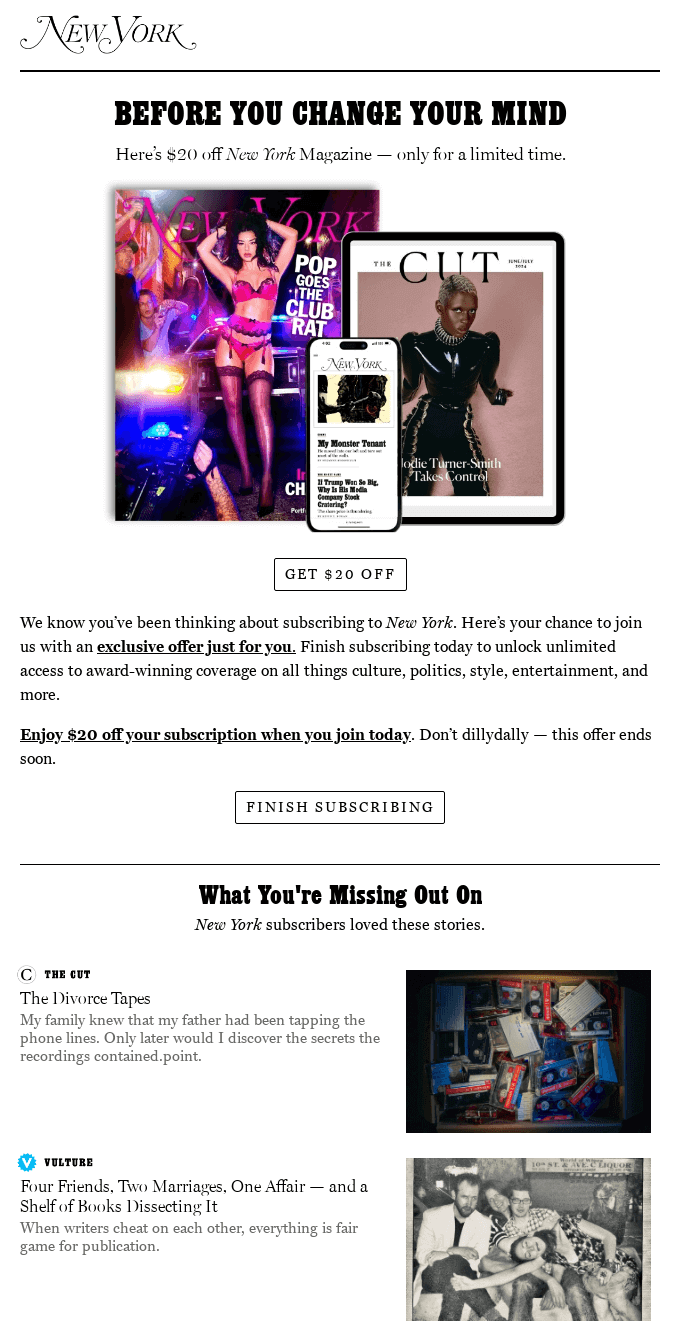
New Yorker’s email on Really Good Emails
“A quick question for you”
This email uses a survey to win back lost subscribers or customers. It may be a feedback request for why they canceled their subscription or stopped engaging. This makes them feel their opinions matter, and may lead to them rethinking their decision.
Subject line ideas:
- A quick question for you, [First Name]
- Got a minute? We’d love your feedback!
- Help us improve, [First Name] – your opinion matters.
Re-engagement email example:
This SeeSo email would definitely win me back. The mix of humor, nostalgia, and vulnerability in the PS section makes it nearly impossible not to smile. It humanizes the brand, making subscribers consider coming back.
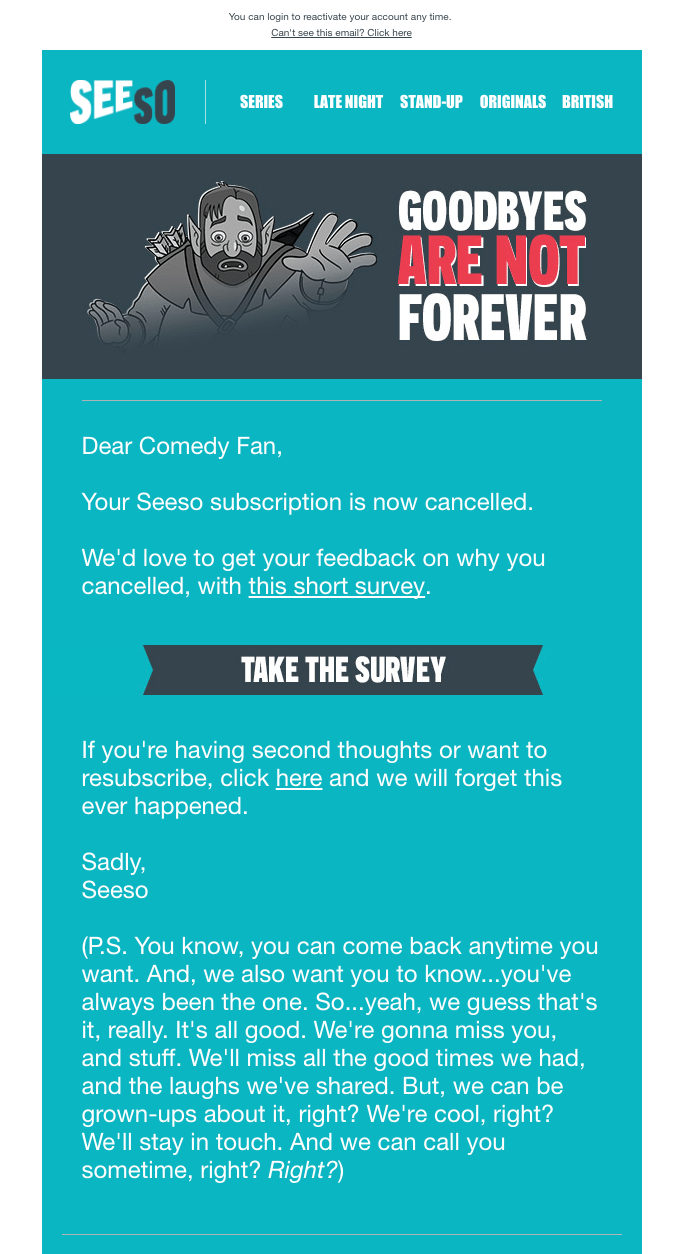
Seeso’s email on Really Good Emails
D. Last chance re-engagement emails
These are “now or never” re-engagement emails. They make it clear that it’s the final opportunity for subscribers to take action. The sense of urgency pushes those who want to remain to re-engage. As for those who don't, it’s time to say goodbye and focus on the re-engaged ones.
“Should we stop sending you emails?”
This email uses the direct approach. It puts the ball in the subscriber’s court and encourages them to make a choice that benefits them. Often, they’re reluctant to stop receiving emails and decide to remain subscribed.
Subject line ideas:
- It’s decision time: Stay or go?
- Should we stop sending you emails?
- Do you still want to hear from us, [First Name]?
Re-engagement email example:
Cuisinart's email is a great example of giving subscribers the power to choose. It doesn't make any offers to guilt-trip them into staying. Instead, the option to update preferences will appeal to many subscribers, as it allows them to take control of their inboxes without completely cutting ties.

Cuisinart’s email on Really Good Emails
“Your account will be deactivated”
This email is urgency-driven and demands subscribers take immediate action. By threatening to deactivate their account or subscription within a specific time frame, subscribers are compelled to act to avoid losing access to something valuable.
Subject line ideas:
- Your account will be deactivated soon
- Don’t miss out. Your account is at risk
- Last chance to keep your [account/subscription] active
Re-engagement email example:
This re-engagement email example from Strava is a good mix of urgency and empathy. They explain why they would deactivate the account: “We want to protect you.” They also provide clear next steps: either log in to keep the account or delete it.
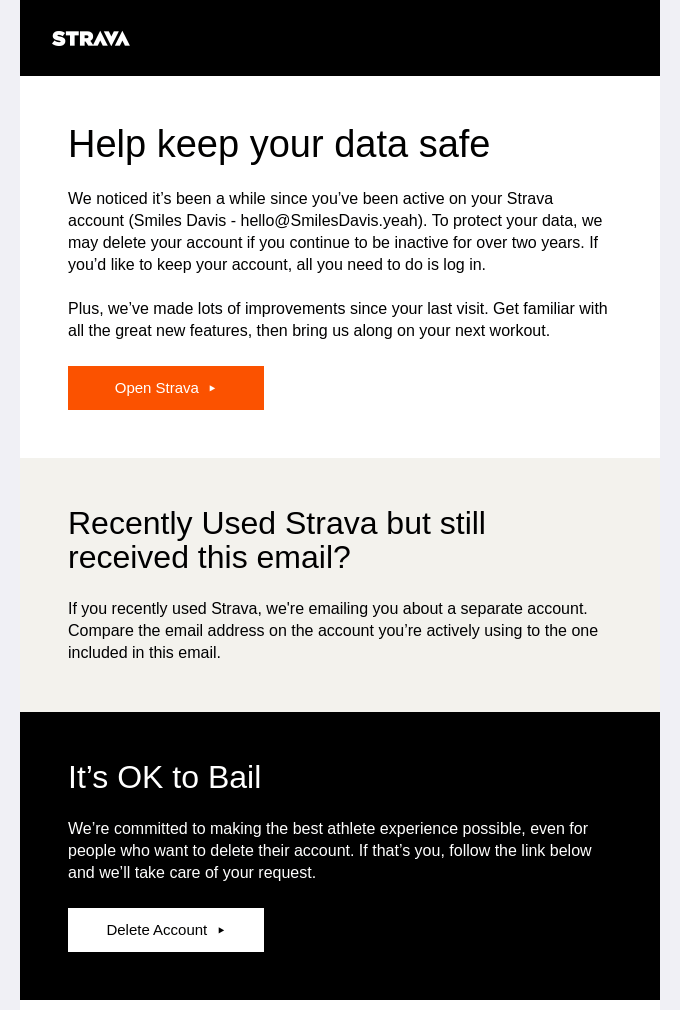
Strava’s email on Really Good Emails
“We’re about to say goodbye”
This email type is the last push to get subscribers to engage and stay on your list. The thought of saying a final goodbye can make them realize they still care about the value they receive and prompt them to re-engage.
Subject line ideas:
- Last call: Want to let us go?
- Your final chance to stay with us
- We’re about to say goodbye, [First Name]
Re-engagement email example:
ReadyMag’s email combines respect and urgency. The tone is considerate and acknowledges the subscriber's likely flooded inbox. But it also gives them a clear deadline for when they’ll be unsubscribed if they don’t take action.
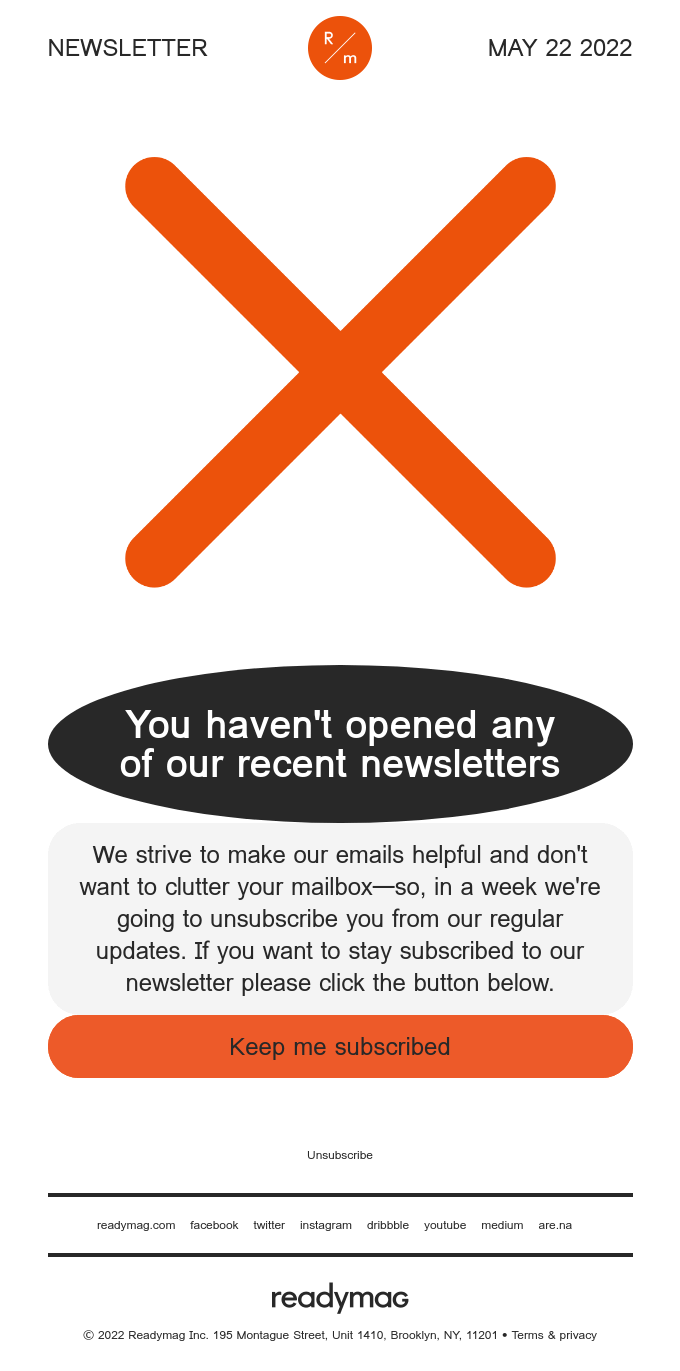
ReadyMag’s email on Really Good Emails
E. Unexpected re-engagement emails
Sometimes, you need to zig when subscribers are expecting you to zag. These unexpected re-engagement email examples ditch the discount, FOMO, and urgency. Instead, they use curiosity, emotion, and weird charm to win back subscribers.
“Maybe this isn’t for you anymore?”
The reverse psychology in this re-engagement email comes as a surprise. Instead of pushing hard for subscribers to come back, tell them it’s okay to let go. This triggers a “Wait, what?” moment. But make sure you keep the tone light and playful.
Subject line ideas:
- Maybe this isn’t for you anymore?
- We don’t want to bother you, so…
- Still interested? No hard feelings if you’re not
Re-engagement email example:
Belgian Boys' cheeky, chocolate-coated email makes subscribers pause and reconsider. Plus, the images of the delicious sweet treat options are a subtle reminder of what they'd be missing out on.
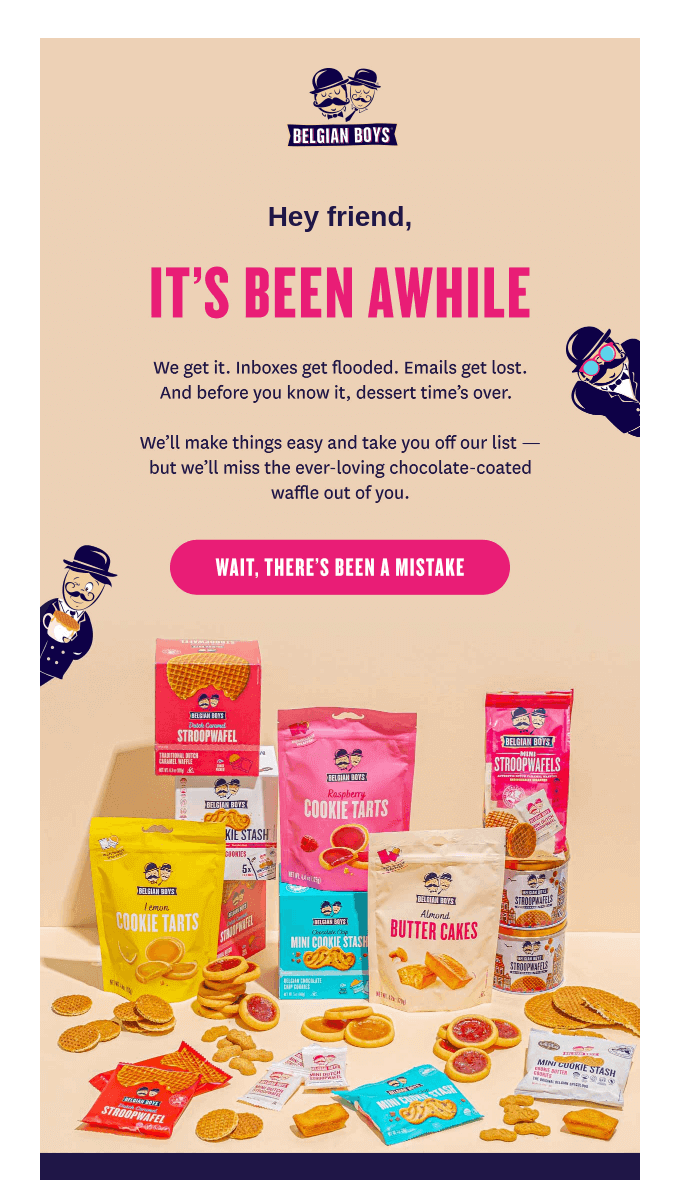
Belgian Boys’ email on Really Good Emails
“Remember when…?”
This email type rekindles the connection with your brand through storytelling. Everyone loves a good trip down memory lane. Reminding subscribers of why they joined your list or previous interactions can get them to re-engage.
Subject line ideas:
- Let’s pick up where we left off
- Remember when you first found us?
- Still thinking about that one time you [did XYZ]
Re-engagement email example:
This example from Mode Chocolate made me laugh. The re-engagement email turned a casual site visit into a full-blown rom-com story. It's unexpected and creates a likeable character out of the product, making the brand memorable.
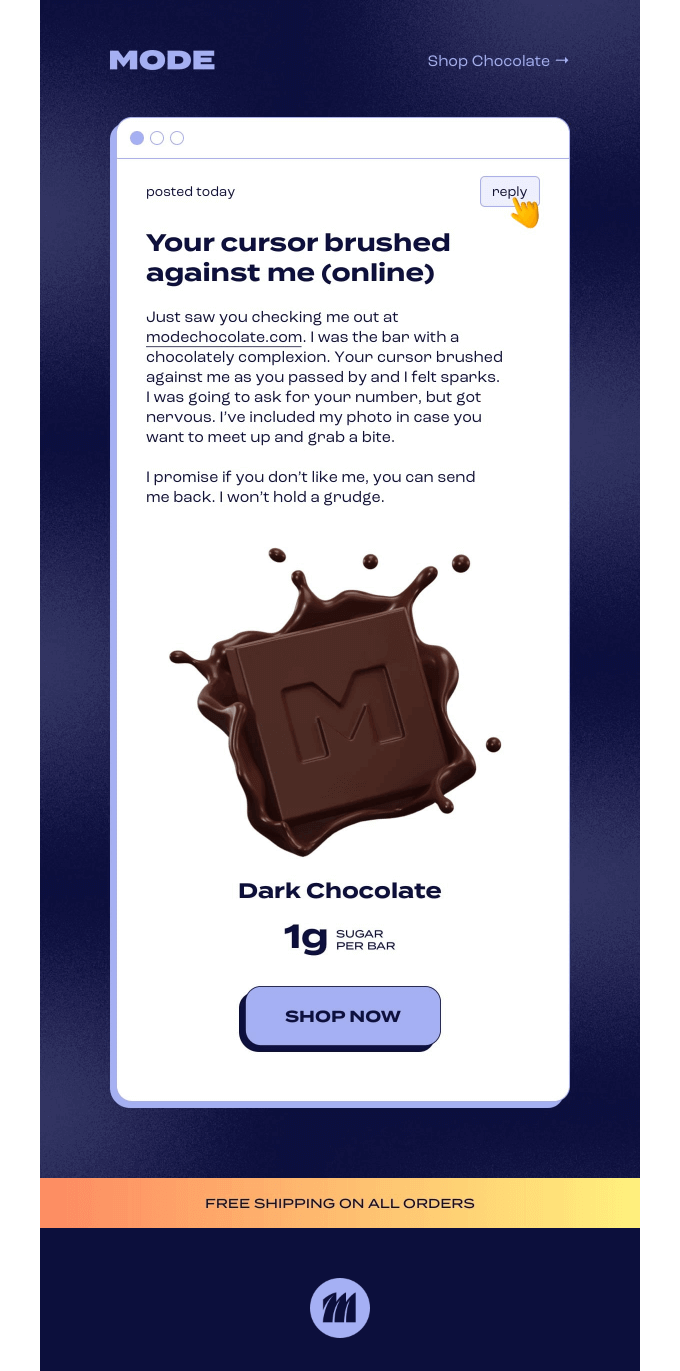
Mode Chocolate’s email on Really Good Emails
When to send a re-engagement email
Sending a re-engagement email too soon can come off as desperate. But wait too long, and your subscribers might forget who you are and may even flag you as spam.
So, when is the right time? When you notice that subscribers aren’t engaging. However, there are different levels of disengagement and inactivity.
- Completely cold. No opens, no clicks, no engagement
- Passive but still warm. They open emails but don’t click or buy
- Used to engage, but went silent. Maybe even purchased once but never returned
- Almost converted, then disappeared. This could be an abandoned cart, free trial, or sign up
Once you’ve identified the level of disengagement, you can then send a suitable re-engagement email. Here’s a basic sending time range:
- 2-7 days after cart abandonment – a quick reminder
- 30-60 days of inactivity – A light “still interested” nudge email
- 90+ days of inactivity – A stronger message with urgency or an offer.
- 120+ days of inactivity – Last-chance email before removing them.
Bottom line? Re-engagement isn’t just about what you say in the email. It’s also about when you say it. Send the right email at the right moment, and you have a solid chance at winning back subscribers and customers.
5 pro tips for writing re-engagement emails that work
Of course, it’s not enough to get people to open your email. What you really want is to get them to take action. You want them to click and convert, whether that’s making a purchase or reading your blog post. Here are five tips to help you do that:
Monitor engagement metrics
You don’t just decide to send re-engagement emails. You need to know how (and if) subscribers are engaging. So, always keep track of your open rates, clicks, site visits, cart activity, and purchase history. These metrics will tell you who and how many are cold, passive, or warm.
Personalize your re-engagement emails
The more you personalize, the more relevant your email feels. Go beyond adding the subscribers’ first name to the subject and first line. You can set up dynamic content in your emails, like product recommendations based on past behavior, special offers tailored to preferences, or discounts on recurring purchases.
Keep the tone friendly, not pushy
Avoid being too aggressive in your re-engagement email (or any type of email campaign at all). Your goal isn’t to force a decision; it’s to warmly invite them back into engaging with you. So use a conversational, friendly tone that makes them feel like they’re getting something valuable. You may also use humor to reconnect with them.
Use segmentation to send the tailored emails
Segment your list based on engagement levels. This will help you send re-engagement emails that resonate with each group of disengaged subscribers. For instance, you don’t want to send the same email to someone who hasn’t opened your emails in 6 months and someone who abandoned their cart 72 hours ago.
Set up a re-engagement trigger flow
Don’t wait for disengaged and inactive subscribers to pile up. Most ESPs have a free autoresponder that allows you to build an automated system to send re-engagement emails based on subscribers’ actions or inactions. For instance, you can set up a trigger flow to send a light nudge email when a subscriber hasn’t opened in 30 days and another follow-up email in 60 days.
Final Thoughts: Give inactive subscribers a reason to re-engage
Subscribers who haven’t opened, clicked, or made a purchase in months aren’t “dead.” They raised their hand once. They were interested at one point. And with the right re-engagement email, you can win them back.
The key is to approach re-engagement with intention, creativity, and respect for your subscribers’ time and attention. You have everything you need in this post: re-engagement email examples, subject line ideas, and pro tips to get subscribers to engage with you again.
Remember, your emails should feel like they’re from a real person who cares – not someone desperate for clicks and sales. And if, after everything, they’re still uninterested, then it’s okay to let them go and keep your list clean and healthy.
Now, it's time to start crafting your re-engagement emails. If you have any questions or have an interesting re-engagement email example, feel free to drop them in the comments.
Our Methodology
This article has been written and researched following our EmailTooltester methodology.
Our Methodology
